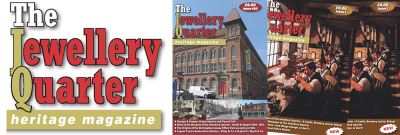We have put together a short but interesting walk in The Jewellery Quarter:
Start your journey on the corner of Legge Lane/Frederick Street.
Opposite is Graham Street) – RH side – The Sikh Temple (formerly a congregational chapel). LH side – Victoria Works (penmakers) – with stone pediment depicting Queen Victoria’s head.
On corner of Legge Lane/Frederick Street is the birthplace of Rip Van Winkle, according to Washington Irving’s classic tale.
The Argent Centre is undoubtedly the Quarter’s most beautiful building. It was built for W.E. Wiley for the manufacture of pencils, penholders, and gold pens. The Pen Room museum is housed in this building and it is a ‘must’ for visitors. A recent addition is a display of badges made by Reeves Badges who manufactured football badges for every football club in the world.
Walk up Frederick Street to Albion Street. Opposite is a building with the most amazing sculptured ‘heads’ on what was Sovereign Hall.
Turn left into Albion Street – passing several traditional manufacturing units (mostly casters). You will then come to the Evans Silver Museum. When the silver manufacturing company closed down, English Heritage took over the building, removing everything in order to carry out repairs, and then putting everything back exactly as it was left by the workers. The bays to the flat windows were added around 1900 to give more workspace.
A few yards further along Albion Street is the old Fire Station (now a nursery). which was at one time ‘the busiest fire station in the country’ where the firemen worked 24 hour on/24 hour off shifts and spent a lot of their time ‘freeing’ workers from machinery (no Health & Safety Regulations in those days!
You are now in Dayus Square, which has been constructed this year (2012) to commemorate the life of author Kathleen Dayus (A Girl from Hockley) and a sculpture can be seen in the Square commemorating her life. It depicts pages tumbling from a book. Kathleen was born close to the derelict building with a pointed roof which was a school and she used to beg, barefoot, outside the George & Dragon pub (also derelict at the moment) for pennies to buy food for her many siblings (whilst her parents drank inside the pub!)
The hill in Carver Street is where the dray horses from the brewery set off sparks with their hoofs as they slipped on the cobbled street.
Turn left into Tenby Street, LH (8/10) – it is possible to recognise how the back-to-back slum houses were converted into workshops by the jewellers. The facade of this building is listed and is where Marie Haddleton was born in 1929).
On the other side of the Tenby Street was the factory of Reeves Badges (a display of badges made by Reeves Badges has recently been unveiled in The Pen Room).
Opposite the corner of Frederick Street/Albion Street is the Natwest Bank, built in 1903 and on the corner of Frederick Street/Regent Street is ‘Thomas Fattorini’ who specialise in regalia etc (they manufactured the badges for the 8,000 2012 Olympic Games torches.
On the opposite corner of Regent Street is the Vertu Bar. This building together with the next door white painted building was once a button/buckle making factory.
Continue towards The Chamberlain Clock, passing on the LH side what was a British Restaurant during WW2, providing cheap and cheerful dinners for workers.
Cross over Warstone Lane, taking in the Cemetery Lodge and the Boulder Stone and read the interpretation board in the Warstone Lane cemetery, then continue walking along Vyse Street until you reach the award winning Museum of The Jewellery Quarter.















